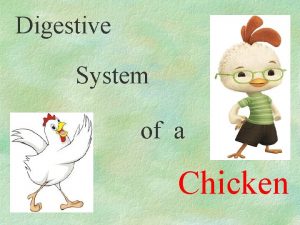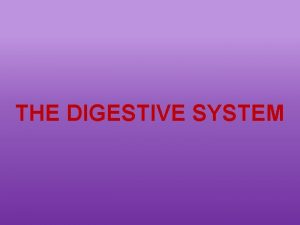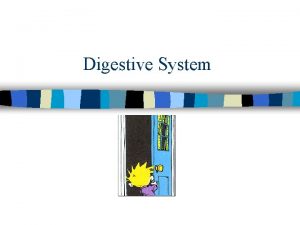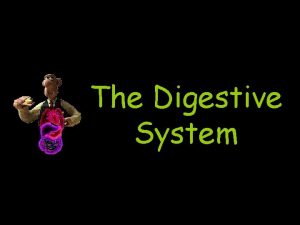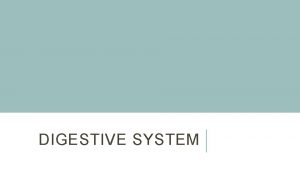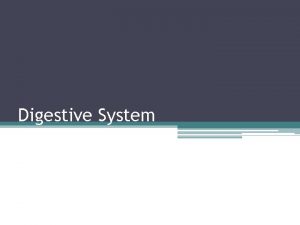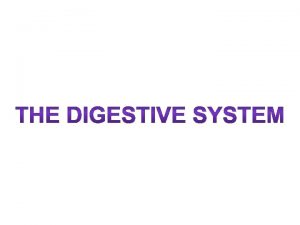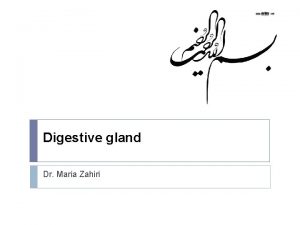The Digestive System Foundation Standard 1 Academic Foundation
































- Slides: 32


The Digestive System • Foundation Standard 1: Academic Foundation Understand human anatomy, physiology, common diseases and disorders, and medical math principles. 1. 13 Analyze basic structures and functions of human body systems • Structures of the gastrointestinal tract • Functions of the gastrointestinal tract • Structures of the accessory organs • Functions of the accessory organs • Chemical digestion • Mechanical digestion 1. 21 Describe common diseases and disorders of each body system • Etiology • Pathology • Diagnosis • Treatment • Prevention 2

Digestion • The breaking down of large food molecules into molecules small enough to be used by the body’s cells for growth, repair, and energy production • Digestive Processes: – Ingestion – Digestion • Mechanical Digestion • Chemical Digestion – Absorption – Defecation 1. 13 Analyze basic structures and functions of human body systems (digestive). j. Digestive (structures and functions of gastrointestinal tract, chemical and mechanical digestion, structures and functions of accessory organs) 3

The Digestive System 1. 13 Analyze basic structures and functions of human body systems (digestive). j. Digestive (structures of gastrointestinal tract, structures of accessory organs) 4

The Digestive System • Gastrointestinal Tract • Alimentary Canal – A continuous tube running through the ventral body cavity extending from the mouth to the anus. 1. 13 Analyze basic structures and functions of human body systems (digestive). j. Digestive (structures) 5

Digestion The breakdown of food so that its nutrients can be used by the body for: • • Energy Growth Cell repair Types of digestion – Mechanical – Chemical 1. 13 Analyze basic structures and functions of human body systems (digestive). j. Digestive (functions of gastrointestinal tract, chemical and mechanical digestion) 6

The Digestive System Organs of the Digestive System – – – mouth pharynx esophagus stomach small intestine large intestine Accessory Organs of the Digestive System – – – teeth tongue salivary glands liver gallbladder pancreas 1. 13 Analyze basic structures and functions of human body systems (digestive). j. Digestive (structures, structures of accessory organs) 7

Mouth (Oral or Buccal Cavity) • Teeth • Hard Palate • Soft Palate – Uvula • Tongue • Uvula • Salivary glands 1. 13 Analyze basic structures and functions of human body systems (digestive). j. Digestive (structures of gastrointestinal tract) 8

Teeth Accessory structures of the digestive system • Deciduous teeth (baby teeth) - 20 • Permanent teeth - 32 – Incisors (8) - 4 on top, 4 on bottom ü chisel shaped - front of mouth – Canines (4) - 2 on top, 2 on bottom ü sharp pointed tearing teeth – Premolars (8) - 4 on top, 4 on bottom – Molars (12) - 6 on top, 6 on bottom ü broad, flat, crushing teeth 1. 13 Analyze basic structures and functions of human body systems (digestive). j. Digestive (structures of gastrointestinal tract) 9

Mechanical Digestion • Starts in the mouth • Chewing (mastication) – tongue manipulates and mixes the food – teeth grind up the food and mix it with saliva • Produces a soft flexible mass of food called a bolus. 1. 13 Analyze basic structures and functions of human body systems (digestive). j. Digestive (functions of gastrointestinal tract, mechanical digestion) 10

Chemical Digestion: • Salivary glands – Secrete saliva ü Salivary amylase digestive enzyme – Begins carbohydrate digestion in the mouth – Lysozyme ü Destroys bacteria in the mouth 1. 13 Analyze basic structures and functions of human body systems (digestive). j. Digestive (functions of gastrointestinal tract, chemical digestion) 11

Mechanical Digestion Swallowing • Deglutition – Moving food from the mouth (pharynx) to the stomach through the esophagus • Peristalsis – Contraction of the esophagus 1. 13 Analyze basic structures and functions of human body systems (digestive). j. Digestive (functions of gastrointestinal tract, mechanical digestion) 12

Stomach Cardia • Cardiac region, cardiac sphincter • Area of the stomach that surrounds the lower esophageal sphincter. Fundus • Rounded, superior portion of the stomach to the left of the cardia. Body • Large central portion of the stomach Pylorus • Narrow, inferior region of the stomach – pyloric sphincter - opening to the duodenum 1. 13 Analyze basic structures and functions of human body systems (digestive). j. Digestive (structures of gastrointestinal tract) 13

Mechanical Digestion • Rugae allow expansion of stomach • Maceration - mixing waves that churns the food inside • Chyme - food mixes with gastric juices and is converted into a thin liquid 1. 13 Analyze basic structures and functions of human body systems (digestive). j. Digestive (mechanical digestion) 14

Chemical Digestion • Secrete digestive enzymes and mucus – Pepsin - digestion of proteins, chief cells – Hydrochloric acid (HCl) - activates other enzymes, parietal cells – Intrinsic Factor - needed to absorb Vitamin B 12 – Mucus - protects the stomach mucosa from the acidic environment 1. 13 Analyze basic structures and functions of human body systems (digestive, ). j. Digestive (chemical) 15

Chemical Digestion: Absorption - Stomach • Does not participate in the absorption of food molecules into the blood. • However, can absorb some substances through the stomach wall. – – – water weak glucose concentrations electrolytes certain drugs (aspirin) alcohol 16

Small Intestine • Chemical digestion of nutrients and absorption of nutrients is completed in the small intestines – Duodenum – Jejunum – Ileum 1. 13 Analyze basic structures and functions of human body systems (digestive). a. j. Digestive (structures and functions of gastrointestinal tract, chemical and mechanical digestion) 17

Small Intestine Duodenum • The beginning of the small intestine • Attached to the stomach • First 12 to 14 inches Jejunum • Portion of the small intestine after the duodenum • Normally about 8 ft. long Ileum • Final portion of the small intestine • About 12 ft. long • IIleocecal valve (sphincter) - prevents backflow of feces 1. 13 Analyze basic structures and functions of human body systems (digestive). j. Digestive (structures of gastrointestinal tract) 18

Chemical Digestion • Chemical digestion and absorption is completed • Result of the collective effort of pancreatic juice, bile, and intestinal juice. • Results in absorption - passage of digested nutrients into the blood sugars and amino acids or lymph (lipids). 19

Absorption • Villi- folds in the intestinal walls of the mucosa layer of tissue. • Microvilli- extensions of villi – Contain capillaries (absorb sugars and amino acids) and lacteals (absorb glycerol and fatty acids chyle lymph 1. 13 Analyze basic structures and functions of human body systems (digestive). j. Digestive (functions of gastrointestinal tract) 20

Pancreas • Alkaline mixture of fluid and digestive enzymes from the acini cells. • Pancreatic Digestive Enzymes: – Pancreatic Amylase – Carbohydrate digestion – Pancreatic Lipase - Fat digestion – Chymotrypsin –Trypsin – Carboxypeptidase - Protein digestion – Nucleases - Nucleic Acid digestion 1. 13 Analyze basic structures and functions of human body systems (digestive). j. Digestive (chemical digestion, functions of accessory organs) 21

Liver Produces and secretes a liquid called bile • Yellowish, brownish, or olive green • 1 quart daily • Composed of bile salts and pigments (colors), lecithin, and several ions • p. H of 7. 6 - 8. 6 • Excretory product and digestive secretion • Assists in the breakdown of fat molecules (emulsification) • Principle bile pigment is bilirubin 1. 13 Analyze basic structures and functions of human body systems (digestive). j. Digestive (functions of accessory organs) 22

Gallbladder • A pear shaped sac • About 7 - 10 cm long • Located on the bottom surface of the liver • Stores and concentrates bile until needed by the small intestine for the emulsification of fat 1. 13 Analyze basic structures and functions of human body systems (digestive). j. Digestive (structures and functions of accessory organs) 23

Large Intestine • About 1. 5 m (5 ft) in length • Cecum - beginning of the large intestine – Vermiform Appendix • Colon - large tube-like portion of large intestine – ascending colon – transverse colon – descending colon – sigmoid colon • Rectum • Anal canal Anus 1. 13 Analyze basic structures and functions of human body systems (digestive). j. Digestive (structures) 24

Large Intestine • • • Completes absorption Absorption of water Manufacture certain vitamins Formation of feces Expulsion of feces from the body – Diarrhea - feces moves too fast, water not absorbed – Constipation - feces stays too long, too much water absorbed 1. 13 Analyze basic structures and functions of human body systems (digestive). j. Digestive (functions of gastrointestinal tract, ) 25

Diseases and Disorders • • • Appendicitis Cirrhosis of the liver Cholelithiasis Hepatitis Peptic Ulcers Inguinal Hernia 1. 21 Describe common diseases and disorders of each body system - Digestive System 26

Appendicitis • Inflammation of the vermiform appendix. • May be caused by an obstruction of the lumen of the appendix by fecal material, a foreign body, stenosis, a kinking of the organ, or carcinoma. 1. 21 Describe common diseases and disorders of each body system (such as: hepatitis, ulcers). a. Etiology, b. Pathology, c. Diagnosis, d. Treatment, e. Prevention 27

Cirrhosis of the Liver • Distorted or scarred liver tissue due to chronic inflammation. • Commonly caused by hepatitis, chemical exposure, parasites, and alcoholism. • Symptoms include: jaundice, bleeding, edema, and increased sensitivity to drugs and chemicals. 1. 21 Describe common diseases and disorders of each body system (such as: hepatitis, ulcers). a. Etiology, b. Pathology, c. Diagnosis, d. Treatment, e. Prevention 28

Cholelithiasis (Gall Stones) • Crystallization of bile in the gallbladder. • Can block the bile duct causing intense pain (Cholecystitis) • Usually treated with gall stone dissolving drugs, lithotripsy, or surgery 29

Hepatitis • Inflammation of the liver • Can be caused by viruses, drugs, and certain chemicals including steroids and alcohol. • Many different types of Hepatitis including: – Hepatitis A (food) – Hepatitis B (body fluids), can lead to cirrhosis and liver cancer – Hepatitis C (body fluids), can lead to cirrhosis and liver cancer 30

Peptic Ulcers • Crater-like lesions that develop in the gastrointestinal tract. • Gastric Ulcers Stomach • Duodenal Ulcers Duodenum • Commonly caused by hypersecretion of gastric juices and acids. • Contributing factors include: – stress, cigarette smoking, certain foods, some medications, and bacterial infections. (Helicobacter pylori) 31

Inguinal Hernia • Part of the intestine protrudes through a weak point or tear in the abdominal wall. • This protrusion creates a bulge which can be painful. • Some inguinal hernias occur at birth when the abdominal lining does not close properly. • Other inguinal hernias occur later in life when muscles weaken or deteriorate. • The most common treatment is surgery. 32
 Foundation standard 1 academic foundation
Foundation standard 1 academic foundation Respiratory system circulatory system digestive system
Respiratory system circulatory system digestive system Nervous system and digestive system
Nervous system and digestive system Pile foundation details
Pile foundation details Foundation standard 4 employability skills
Foundation standard 4 employability skills Foundation standard 4 employability skills
Foundation standard 4 employability skills Foundation standard 4 employability skills
Foundation standard 4 employability skills Foundation standard 4 employability skills
Foundation standard 4 employability skills Foundation standard 4 employability skills
Foundation standard 4 employability skills Hát kết hợp bộ gõ cơ thể
Hát kết hợp bộ gõ cơ thể Frameset trong html5
Frameset trong html5 Bổ thể
Bổ thể Tỉ lệ cơ thể trẻ em
Tỉ lệ cơ thể trẻ em Gấu đi như thế nào
Gấu đi như thế nào Tư thế worm breton
Tư thế worm breton Hát lên người ơi alleluia
Hát lên người ơi alleluia Các môn thể thao bắt đầu bằng từ đua
Các môn thể thao bắt đầu bằng từ đua Thế nào là hệ số cao nhất
Thế nào là hệ số cao nhất Các châu lục và đại dương trên thế giới
Các châu lục và đại dương trên thế giới Công của trọng lực
Công của trọng lực Trời xanh đây là của chúng ta thể thơ
Trời xanh đây là của chúng ta thể thơ Mật thư tọa độ 5x5
Mật thư tọa độ 5x5 Làm thế nào để 102-1=99
Làm thế nào để 102-1=99 độ dài liên kết
độ dài liên kết Các châu lục và đại dương trên thế giới
Các châu lục và đại dương trên thế giới Thơ thất ngôn tứ tuyệt đường luật
Thơ thất ngôn tứ tuyệt đường luật Quá trình desamine hóa có thể tạo ra
Quá trình desamine hóa có thể tạo ra Một số thể thơ truyền thống
Một số thể thơ truyền thống Cái miệng nó xinh thế chỉ nói điều hay thôi
Cái miệng nó xinh thế chỉ nói điều hay thôi Vẽ hình chiếu vuông góc của vật thể sau
Vẽ hình chiếu vuông góc của vật thể sau Nguyên nhân của sự mỏi cơ sinh 8
Nguyên nhân của sự mỏi cơ sinh 8 đặc điểm cơ thể của người tối cổ
đặc điểm cơ thể của người tối cổ V. c c
V. c c











































